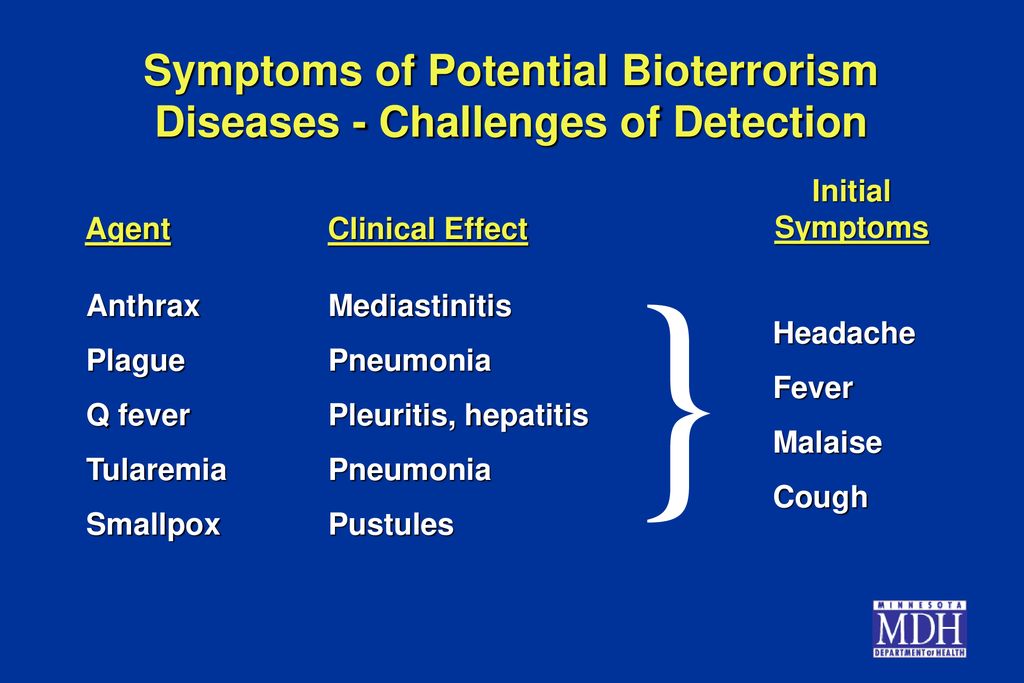Early Biological Attack Symptoms: Recognizing the Unseen Threat
The chilling prospect of a biological attack looms large in the age of global interconnectedness. Understanding the early warning signs is crucial, not only for individual preparedness but also for swift, effective public health responses. This article will delve into the common early symptoms of various biological attacks, highlighting the importance of vigilance and timely medical intervention.
Understanding the Threat: Types of Biological Weapons
Biological weapons utilize pathogens – disease-causing organisms – to inflict widespread harm. These can include:
- Bacteria: Examples include Bacillus anthracis (anthrax), Yersinia pestis (plague), and Brucella species (brucellosis).
- Viruses: Such as smallpox, Ebola, and influenza (highly pathogenic strains).
- Toxins: These are poisonous substances produced by living organisms, like botulinum toxin (botulism) and ricin.
The specific symptoms will vary significantly depending on the agent used, however, there are some commonalities that warrant attention.
Common Early Symptoms Across Biological Attacks:
While symptoms differ based on the specific pathogen, some early signs might indicate a biological attack. It's crucial to remember that many of these symptoms mimic common illnesses, making early detection challenging. However, the sudden appearance of these symptoms in a large number of individuals within a specific geographic area should raise serious concern.
- Fever and chills: A sudden onset of high fever accompanied by shivering is a frequent indicator.
- Fatigue and weakness: Extreme tiredness and overall weakness are common across various biological agents.
- Muscle aches: Generalized muscle pain and stiffness can be an early warning sign.
- Headache: Severe and persistent headaches should not be dismissed.
- Respiratory symptoms: Cough, shortness of breath, and difficulty breathing can indicate a respiratory-borne agent.
- Gastrointestinal distress: Nausea, vomiting, diarrhea, and abdominal cramps may be present, especially with toxins or certain bacterial infections.
- Skin lesions: Rashes, blisters, or ulcers may appear, depending on the agent. Anthrax, for instance, can manifest as skin lesions.
Specific Agent Symptoms (Illustrative, Not Exhaustive):
This section offers examples; it is critical to consult official health resources for detailed information.
- Anthrax: Skin lesions that develop into painless ulcers with a black center are a key symptom. Inhalational anthrax presents with flu-like symptoms progressing to severe respiratory distress.
- Plague: Symptoms can range from swollen lymph nodes (bubonic plague) to pneumonia (pneumonic plague), often accompanied by high fever.
- Smallpox: High fever, severe headache, backache, and a characteristic rash that progresses from flat spots to raised bumps and then to fluid-filled blisters.
What to Do If You Suspect a Biological Attack:
- Seek immediate medical attention: Do not attempt self-treatment. Inform medical professionals of your concerns and any potential exposure.
- Follow official guidelines: Authorities will issue instructions on appropriate actions; heed these instructions carefully.
- Avoid contact with potentially contaminated areas: If a biological attack is suspected, stay away from affected areas until official clearance is given.
- Practice good hygiene: Wash your hands frequently with soap and water.
Conclusion: Preparedness is Key
Recognizing the early symptoms of a biological attack is crucial for minimizing the impact of such a devastating event. While many symptoms mimic common illnesses, the sudden widespread appearance of several of these symptoms, particularly within a defined geographic location, warrants immediate attention and action. Staying informed, following public health guidelines, and seeking prompt medical assistance are vital steps in mitigating the threat.
Disclaimer: This article provides general information and should not be considered medical advice. Always consult with a healthcare professional for any health concerns. For the most up-to-date information on biological threats, refer to official sources such as the Centers for Disease Control and Prevention (CDC) and the World Health Organization (WHO).

